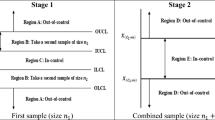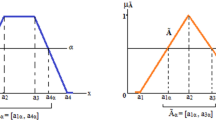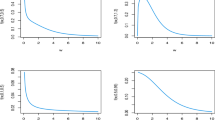Abstract
The coefficient of variation is a useful statistical measure, which has long been widely used in many areas. In real-world applications, there are situations where the observations are inexact and imprecise in nature and they have to be estimated. This paper investigates the sample coefficient of variation (CV) with uncertain observations, which are represented by interval values. Since the observations are interval-valued, the derived CV should be interval-valued as well. A pair of mathematical programs is formulated to calculate the lower bound and upper bound of the CV. Originally, the pair of mathematical programs is nonlinear fractional programming problems, which do not guarantee to have global optimum solutions. By model reduction and variable substitutions, the mathematical programs are transformed into a pair of quadratic programs. Solving the pair of quadratic programs produces the global optimum solutions and constructs the interval of the CV. The given example shows that the proposed model is indeed able to help the manufacturer select the most suitable manufacturing process with interval-valued observations.

Similar content being viewed by others
References
Almeida CWD, Souza RMCR, Candeias ALB (2013) Fuzzy Kohonen clustering networks for interval data. Neurocomputing 99:65–75
Bazaraa MS, Sherali HD, Shetty CM (1993) Nonlinear programming- theory and algorithm, 2nd edn. Wiley, New York
Benson HP (2006) Fractional programming with convex quadratic forms and functions. Eur J Oper Res 173:351–369
Ben-Tal A, Boyd S, Nemirovski A (2006) Extending scope of robust optimization: comprehensive robust counterparts of uncertain problems. Math Program 107:63–89
Ben-Tal A, Nemirovski A (2000) Robust solutions of linear programming problems contaminated with uncertain data. Math Program 88:411–424
Ben-Tal A, Nemirovski A (2008) Selected topics in robust convex optimization. Math Program 112B:125–158
Cambini R, Sodini C (2010) A unifying approach to solve some classes of rank-three multiplicative and fractional programs involving linear functions. Eur J Oper Res 207:25–29
Černý M, Hladík M (2014) The complexity of computation and approximation of the t-ratio over one-dimensional interval data. Comput Stat Data Anal 80:26–43
Chang CT (2002) On the posynomial fractional programming problem. Eur J Oper Res 143:42–52
Charnes A, Cooper WW (1962) Programming with linear fractional functional. Nav Res Logist Q 9:181–186
Christodoulou C, Bugmann G (2001) Coefficient of variation vs. mean interspike interval curves: what do they tell us about the brain? Neurocomputing 38–40:1141–1149
Cooper WW, Park KS, Yu G (1999) IDEA and AR-IDEA: models for dealing with imprecise data in DEA. Manag Sci 45:597–607
Dai J, Wang W, Mi JS (2013) Uncertainty measurement for interval-valued information systems. Inf Sci 251:63–78
Dymova L, Sevastjanov P, Tikhonenko A (2013) A direct interval extension of TOPSIS method. Expert Syst Appl 40:4841–4847
Dymova L, Sevastjanov P, Tikhonenko A (2015) An interval type-2 fuzzy extension of the TOPSIS method using alpha cuts. Knowl Based Syst 83:116–127
Goberna MA, Jeyakumar V, Li G, Vicente-Pérez J (2014) Robust solution of multiple-objective linear semi-infinite programs under constraint data uncertainty. SIAM J Optim 24:1402–1419
Goberna MA, Jeyakumar V, Li G, Vicente-Pérez J (2015) Robust solutions to multiple-objective linear programs with uncertain data. Eur J Oper Res 242:730–743
Guo J, Li W, Li C, Gao S (2012) Standardization of interval symbolic data based on the empirical descriptive statistics. Comput Stat Data Anal 56:602–610
He X, Oyadiji SO (2001) Application of coefficient of variation in reliability-based mechanical design and manufacture. J Mater Process Technol 119:374–378
Hladík M (2010) Generalized linear fractional programming under interval efficiency. Eur J Oper Res 205:42–46
Hladík M (2011) Optimal value bounds in nonlinear programming with interval data. TOP 19:93–106
Hladík M, Černý M (2012) Interval regression by tolerance analysis approach. Fuzzy Sets Syst 193:85–107
Iancu DA, Trichakis N (2014) Pareto efficiency in robust optimization. Manag Sci 60:130–147
Ishibuchi H, Tanaka H (1990) Multiobjective programming in optimization of the interval objective function. Eur J Oper Res 48:219–225
Jiang C, Zhang ZG, Zhang QF, Han X, Xie HC, Liu J (2014) A new nonlinear interval programming method for uncertain problems with dependent interval variables. Eur J Oper Res 238:245–253
Kalczynski PJ, Kamburowski J (2006) A heuristic for minimizing the expected makespan in two-machine flow shops with consistent coefficients of variation. Eur J Oper Res 169:742–750
Kreinovich V, Nguyen HT, Wu B (2007) On-line algorithms for computing mean and variance of interval data. Inf Sci 177:3228–3238
Liu ST (2006) Posynomial geometric programming with parametric uncertainty. Eur J Oper Res 162:345–353
Liu ST (2008) Posynomial geometric programming with interval exponents and coefficients. Eur J Oper Res 186:17–27
Liu ST (2011) Mean-absolute deviation portfolio selection problem with interval-valued returns. J Comput Appl Math 235:4149–4157
Mahapatra GS, Mandal TK (2012) Posynomial parametric geometric programming with interval valued coefficient. J Optim Theory Appl 154:120–132
Mahapatra GS, Roy TK (2012) Reliability evaluation of complex system with fuzzy reliability of components using interval nonlinear programming. Electron J Appl Stat Anal 5:151–163
Neto EAL, Carvalho FAT (2010) Constrained linear regression models for symbolic interval-valued variables. Comput Stat Data Anal 54:333–347
Oliveira C, Antunes CH, Barrico C (2014) An enumerative algorithm for computing all possibly optimal solutions to an interval LP. TOP 22:530–542
Pal D, Mahapatra GS, Samanta GP (2013) Optimal harvesting of prey-predator system with interval biological parameters: a bioeconomic model. Math Biosci 241:181–187
Pang WK, Yu BWT, Troutt MD, Hou SH (2008) A simulation-based approach to the study of coefficient of variation of dividend yields. Eur J Oper Res 189:559–569
Pardalos PM (1986) An algorithm for a class of nonlinear fractional problems using ranking of the vertices. BIT 26:392–395
Reed GF, Lynn F, Meade BD (2002) Use of coefficient of variation in assessing variability of quantitative assays. Clin Diagn Lab Immunol 9:1235–1239
Roy P, Mahapatra BS, Mahapatra GS, Roy PK (2014) Entropy based region reducing genetic algorithm for reliability redundancy allocation in interval environment. Expert Syst Appl 41:6147–6160
See CT, Sim M (2009) Robust approximation to multiperiod inventory management. Oper Res 58:583–594
Sengupta A, Pal TK (2000) On comparing interval numbers. Eur J Oper Res 127:28–43
Sevastjanov P (2007) Numerical methods for interval and fuzzy number comparison based on the probabilistic approach and Dempster-Shafer theory. Inf Sci 177:4645–4661
Spadoni M, Stefanini L (2011) Computing the variance of interval and fuzzy data. Fuzzy Sets Syst 165:24–36
Vavasis SA (1991) Nonlinear optimization: complexity issues. Oxford University Press, New York
Wang YM, Yang JB, Xu DL (2005) A preference aggregation method through the estimation of utility intervals. Comput Oper Res 32:2027–2049
Wang CF, Shen PP (2008) A global optimization algorithm for linear fractional programming. Appl Math Comput 204:281–287
Wu HC (2010) Duality theory for optimization problems with interval-valued objective functions. J Optim Theory Appl 144:615–628
Acknowledgments
Research was supported by the National Science Council of Republic of China under Contract No. NSC102-2410-H-238-005. The author is indebted to editor and the reviewers for their constructive comments that significantly improved the quality of this paper.
Author information
Authors and Affiliations
Corresponding author
Rights and permissions
About this article
Cite this article
Liu, ST. A mathematical programming approach to sample coefficient of variation with interval-valued observations. TOP 24, 1–18 (2016). https://doi.org/10.1007/s11750-015-0391-y
Received:
Accepted:
Published:
Issue Date:
DOI: https://doi.org/10.1007/s11750-015-0391-y




